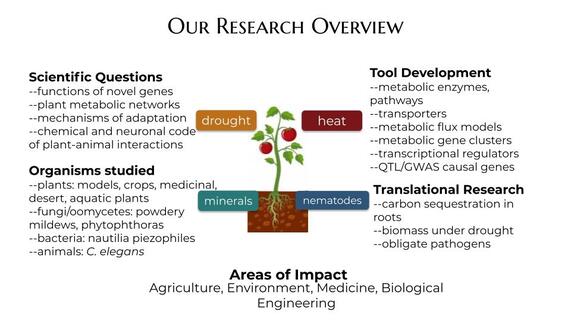|
Our lab combines computational and experimental approaches to reveal molecular mechanisms underlying adaptive strategies in plants. We focus on metabolic traits at multiple scales including individual genes, pathways, and networks. We also uncover novel functions, mechanisms, and pathways of 'unknown' genes (those that are not similar to any known genes), which is taking us to areas of research we never thought of studying before. |
Why should we study plants?Introduction by Ruby Tebbutt, 2022 Summer Intern
|
Front Matter
|
We aim to uncover the molecular mechanisms underlying adaptive traits in the face of heat, drought, nutrient limitation, latitude and pests. We study a variety of plants including models, orphan crops, medicinal and desert plants. More recently our work has involved studying a model nematode C. elegans, fungal pathogens, corals, and piezophilic bacterium. Our group employs computational modeling and targeted laboratory testing to study mechanisms of adaptation, functions of novel genes, organization and function of metabolic networks, and chemical and neuronal code of plant-animal interactions. We are also interested in developing translational research programs involving carbon sequestration by plants and biomass maximization under drought in bioenergy crops. See our Publications and Talks. |
News
July 9th, 2024
The search is on!
The Rhee Lab and the PCA are looking to hire a postdoctoral researcher to develop and apply emerging single cell and spatial omics technologies to address fundamental problems in plant resilience research
Please see the posting on our Overview & Job Openings.
June 28th, 2024
Hot off the presses!
In a new press release, Sue Rhee gives some insight into a large collaborative project between MSU and Stanford University revolutionizing chemotaxis evaluation to help determine the role of plant chemicals in pest defense or pollinator attraction.
Please read the whole story here:
bmb.natsci.msu.edu/news/2024/2024-diy-lab-tool-evaluates-new-molecules-in-minutes.aspx
June 7th, 2024
The search is on!
The Rhee Lab is looking to hire a postdoctoral research associate to work on WALII projects involving microscopy, genetics, and physiology techniques to investigate dehydration and desiccation tolerance in Arabidopsis. Please check our Overview & Job Openings page for more info!
May 8th, 2024
The search is on!
The Rhee Lab is looking to hire a Research Assistant at MSU! This job is perfect for recent college graduates with a degree in biology, biochemistry, or a related field. If this sounds like you, please check our Overview & Job Openings page for updates!
April 19th, 2024
The Banbury Center interviews Sue Rhee!
As part of their "Humans of Banbury" interview series, Sue talks about her experiences in research and running a lab.
Please find the interview on the Banbury Center's website here:
https://www.cshl.edu/banbury-news/humans-of-banbury-interview-with-seung-yon-sue-rhee/
April 17th, 2024
Two REU students will be joining the Rhee Lab this Summer!
Isaiah Kam is a student at Middle Tennessee State University studying Biology with a concentration in Genetics and Biotechnology.
Peyton Vanada is a student at Meredith College studying Biology with minors in Chemistry and Mathematics.
Find more about our Summer Interns on our Current Team Members page!
April 16th, 2024
The Rhee Lab attends MSU's annual SciFest!
Our lab joined other members of the PRI, PCA, PMN, and WALII in helping spread our love of science to people of all ages at three booths this past weekend. Find pictures of the event in our outreach gallery page!
March 7, 2024
New paper in Plant Direct!
Non-destructive, whole-plant phenotyping reveals dynamic changes in water use efficiency, photosynthesis, and rhizosphere acidification of sorghum accessions under osmotic stress (Ginzburg et al., 2024)
https://doi.org/10.1002/pld3.571
The search is on!
The Rhee Lab and the PCA are looking to hire a postdoctoral researcher to develop and apply emerging single cell and spatial omics technologies to address fundamental problems in plant resilience research
Please see the posting on our Overview & Job Openings.
June 28th, 2024
Hot off the presses!
In a new press release, Sue Rhee gives some insight into a large collaborative project between MSU and Stanford University revolutionizing chemotaxis evaluation to help determine the role of plant chemicals in pest defense or pollinator attraction.
Please read the whole story here:
bmb.natsci.msu.edu/news/2024/2024-diy-lab-tool-evaluates-new-molecules-in-minutes.aspx
June 7th, 2024
The search is on!
The Rhee Lab is looking to hire a postdoctoral research associate to work on WALII projects involving microscopy, genetics, and physiology techniques to investigate dehydration and desiccation tolerance in Arabidopsis. Please check our Overview & Job Openings page for more info!
May 8th, 2024
The search is on!
The Rhee Lab is looking to hire a Research Assistant at MSU! This job is perfect for recent college graduates with a degree in biology, biochemistry, or a related field. If this sounds like you, please check our Overview & Job Openings page for updates!
April 19th, 2024
The Banbury Center interviews Sue Rhee!
As part of their "Humans of Banbury" interview series, Sue talks about her experiences in research and running a lab.
Please find the interview on the Banbury Center's website here:
https://www.cshl.edu/banbury-news/humans-of-banbury-interview-with-seung-yon-sue-rhee/
April 17th, 2024
Two REU students will be joining the Rhee Lab this Summer!
Isaiah Kam is a student at Middle Tennessee State University studying Biology with a concentration in Genetics and Biotechnology.
Peyton Vanada is a student at Meredith College studying Biology with minors in Chemistry and Mathematics.
Find more about our Summer Interns on our Current Team Members page!
April 16th, 2024
The Rhee Lab attends MSU's annual SciFest!
Our lab joined other members of the PRI, PCA, PMN, and WALII in helping spread our love of science to people of all ages at three booths this past weekend. Find pictures of the event in our outreach gallery page!
March 7, 2024
New paper in Plant Direct!
Non-destructive, whole-plant phenotyping reveals dynamic changes in water use efficiency, photosynthesis, and rhizosphere acidification of sorghum accessions under osmotic stress (Ginzburg et al., 2024)
https://doi.org/10.1002/pld3.571







